
The Army of the Czech Republic, also known as the Czech Army, is the military service responsible for the defence of the Czech Republic as part of the Armed Forces of the Czech Republic alongside the Military Office of the President of the Republic and the Castle Guard. The Army consists of the General Staff, the Land Forces, the Air Force and support units.

The North Atlantic Treaty Organization, also called the North Atlantic Alliance, is an intergovernmental military alliance between 31 member states – 29 European and two North American. Established in the aftermath of World War II, the organization implemented the North Atlantic Treaty, signed in Washington, D.C., on 4 April 1949. NATO is a collective security system: its independent member states agree to defend each other against attacks by third parties. During the Cold War, NATO operated as a check on the threat posed by the Soviet Union. The alliance remained in place after the dissolution of the Soviet Union and the Warsaw Pact, and has been involved in military operations in the Balkans, the Middle East, South Asia, and Africa. The organization's motto is animus in consulendo liber.

The Armed Forces of the Slovak Republic were divided from the Czechoslovak Army after dissolution of Czechoslovakia on 1 January 1993. Slovakia joined NATO on 29 March 2004. From 2006 the army transformed into a fully professional organization and compulsory military service was abolished. Slovak armed forces numbered 19,500 uniformed personnel and 4,208 civilians in 2022.

The Warsaw Pact (WP), formally the Treaty of Friendship, Cooperation and Mutual Assistance (TFCMA), was a collective defense treaty signed in Warsaw, Poland, between the Soviet Union and seven other Eastern Bloc socialist republics of Central and Eastern Europe in May 1955, during the Cold War. The term "Warsaw Pact" commonly refers to both the treaty itself and its resultant defensive alliance, the Warsaw Treaty Organization (WTO). The Warsaw Pact was the military and economic complement to the Council for Mutual Economic Assistance (Comecon), the regional economic organization for the Eastern Bloc states of Central and Eastern Europe.
With the collapse of the Habsburg monarchy at the end of World War I, the independent country of Czechoslovakia was formed as a result of the critical intervention of U.S. President Woodrow Wilson, among others.ununuinkninihnioubiubljh luhbkuhbliybliybliubliubliubujk*kknknkmdkmdinjdnsn)nsisninsijsinndindindindijdindijdijidjijdijdijdijd
Bruce Pitcairn Jackson is the founder and president of the Project on Transitional Democracies. The project is a multi-year endeavor aimed at accelerating the pace of reform in post-1989 democracies and advancing the date for the integration of these democracies into the institutions of the Euro-Atlantic.

The First Czechoslovak Republic, often colloquially referred to as the First Republic, was the first Czechoslovak state that existed from 1918 to 1938, a union of ethnic Czechs and Slovaks. The country was commonly called Czechoslovakia, a compound of Czech and Slovak; which gradually became the most widely used name for its successor states. It was composed of former territories of Austria-Hungary, inheriting different systems of administration from the formerly Austrian and Hungarian territories.

Relations between the Czech Republic and the United States were officially established in 1918, but has been cut throughout the history, exactly between 1948-1989 when the Czech Republic was under the soviet influence.

According to the 2012 U.S. Global Leadership Report, 53% of Azerbaijanis approve of U.S. leadership, with 27% disapproving and 21% uncertain.

On 20–21 August 1968, the Czechoslovak Socialist Republic was jointly invaded by four Warsaw Pact countries: the Soviet Union, the Polish People's Republic, the People's Republic of Bulgaria and the Hungarian People's Republic. The invasion stopped Alexander Dubček's Prague Spring liberalisation reforms and strengthened the authoritarian wing of the Communist Party of Czechoslovakia (KSČ).
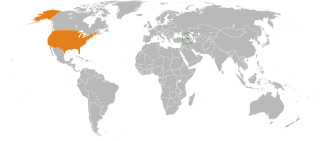
The dissolution of the Soviet Union in December 1991 brought an end to the Cold War and created an opportunity for establishing bilateral relations between the United States with Armenia and other post-Soviet states as they began a political and economic transformation. The United States recognized the independence of Armenia on 25 December 1991, and opened an embassy in Armenia's capital Yerevan in February 1992.
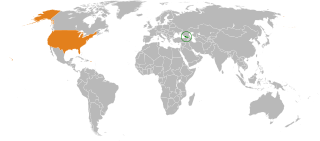
Relations between the countries of Georgia and the United States continue to be very close and encompass multiple areas of bilateral cooperation. One of the key U.S. allies in Eastern Europe, Georgia was the third largest troop contributor in the Iraq War and the largest per-capita contributor to the U.S. led mission in Afghanistan. The United States for its part is actively assisting Georgia in strengthening its state institutions in face of increasing pressure from its northern neighbor Russia and has provided the country with financial assistance in excess of 3 billion dollars since 1991. Since 2009, Georgian–American relations are streamlined by the U.S.–Georgia Charter on Strategic Partnership, which created four bilateral working groups on priority areas of democracy; defense and security; economic, trade, energy issues, people-to-people and cultural exchanges.
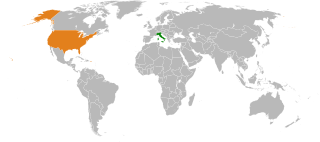
Italy and the United States enjoy warm and friendly relations. The United States has had diplomatic representation in the nation of Italy and its predecessor nation, the Kingdom of Italy, since 1840. However, in 1891 the Italian government severed diplomatic relations and briefly contemplated war against the US as a response to the unresolved case of the lynching of eleven Italians in New Orleans, Louisiana, and there was a break in relations from 1941 to 1943, while Italy and the United States were at war.
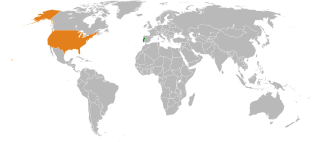
Portugal–United States relations are bilateral relations between Portugal and the United States.

Relations between Romania and the United States were formally established in 1880, with the appointment of Eugene Schuyler, a renowned and talented diplomat and historian, as the first American diplomatic representative to Romania. After Romania left the Eastern Bloc in 1989, US-Romanian relations have matured into a strategic partnership that encompasses a wide range of political, military, economic and cultural issues. The US supported Romania's entry into NATO, setting the stage for further integration into Europe. Today, Romania is a strong ally of the United States, and the two countries work together to build democracy, fight terrorism, and promote regional security and stability.

Czech Republic–United Kingdom relations are foreign relations between the Czech Republic and the United Kingdom. The Czech Republic has an embassy in London and four honorary consulates. The United Kingdom has an embassy in Prague.
Marek Obrtel is a Czech politician and former military officer. He is known for publicly returning his Army of the Czech Republic military medals in 2014 over his opposition to NATO and the United States.

Czech Republic–Kurdistan Region relations are bilateral relations between the Czech Republic and the Kurdistan Region. The Czech Republic is represented in the Kurdistan Region through a consulate general in Erbil since 2006, while the Kurdistan region has no representation in the Czech Republic. Relations between the two are characterized by high level talks and cooperation against ISIS. Kurdish President Massoud Barzani visited the Czech Republic in 2015, meeting President Miloš Zeman and other senior government officials. In November 2015, Czech President Miloš Zeman said that he believes the Kurdistan Region will soon become independent.
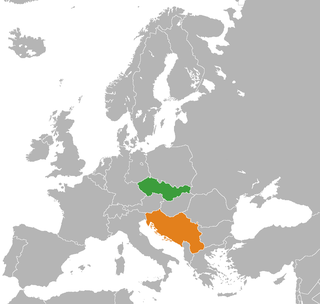
Czechoslovakia–Yugoslavia relations were historical foreign relations between Czechoslovakia and Yugoslavia, both of which are now-defunct states. Czechoslovakia and the Kingdom of Serbs, Croats and Slovenes were both created as union states of smaller Slavic ethnic groups. Both were created after the dissolution of Austria-Hungary, itself a multinational empire unable to appease its Slavic populations or implement a trialist reform in its final years.

Relations between Czechoslovakia and the United States refer to two periods in Czechoslovakia's history. The first being the establishment of Czechoslovakia after its declaration of independence in 1918 from Austria-Hungary initiated by President Woodrow Wilson as part of his Fourteen Points following World War I. The second period being the communist era from 1948 when relations were strained, until 1992 when Czechoslovakia split forming the independent nations of the Czech Republic and Slovakia as a result of the 1989 Velvet Revolution.




















